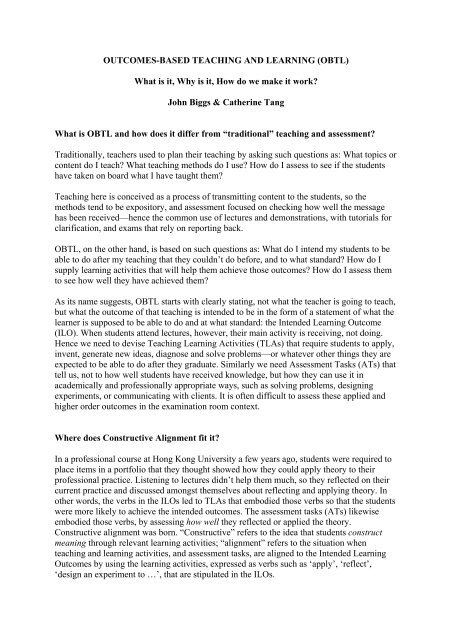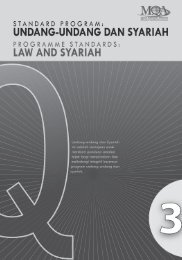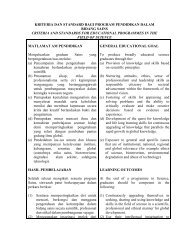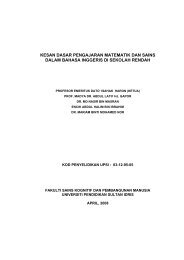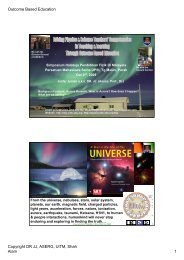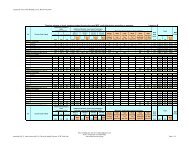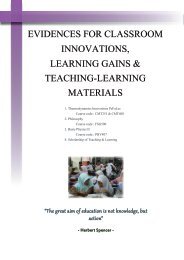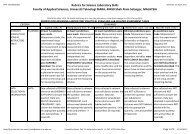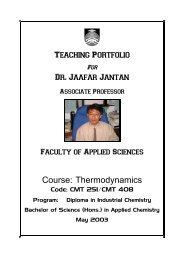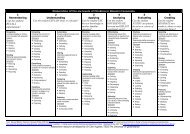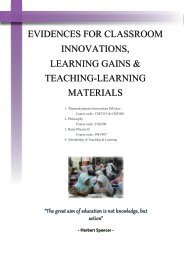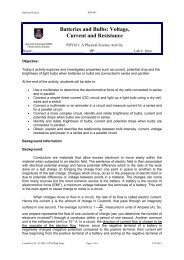OUTCOMES-BASED TEACHING AND LEARNING (OBTL) - DrJJ
OUTCOMES-BASED TEACHING AND LEARNING (OBTL) - DrJJ
OUTCOMES-BASED TEACHING AND LEARNING (OBTL) - DrJJ
You also want an ePaper? Increase the reach of your titles
YUMPU automatically turns print PDFs into web optimized ePapers that Google loves.
<strong>OUTCOMES</strong>-<strong>BASED</strong> <strong>TEACHING</strong> <strong>AND</strong> <strong>LEARNING</strong> (<strong>OBTL</strong>)<br />
What is it, Why is it, How do we make it work<br />
John Biggs & Catherine Tang<br />
What is <strong>OBTL</strong> and how does it differ from “traditional” teaching and assessment<br />
Traditionally, teachers used to plan their teaching by asking such questions as: What topics or<br />
content do I teach What teaching methods do I use How do I assess to see if the students<br />
have taken on board what I have taught them<br />
Teaching here is conceived as a process of transmitting content to the students, so the<br />
methods tend to be expository, and assessment focused on checking how well the message<br />
has been received—hence the common use of lectures and demonstrations, with tutorials for<br />
clarification, and exams that rely on reporting back.<br />
<strong>OBTL</strong>, on the other hand, is based on such questions as: What do I intend my students to be<br />
able to do after my teaching that they couldn’t do before, and to what standard How do I<br />
supply learning activities that will help them achieve those outcomes How do I assess them<br />
to see how well they have achieved them<br />
As its name suggests, <strong>OBTL</strong> starts with clearly stating, not what the teacher is going to teach,<br />
but what the outcome of that teaching is intended to be in the form of a statement of what the<br />
learner is supposed to be able to do and at what standard: the Intended Learning Outcome<br />
(ILO). When students attend lectures, however, their main activity is receiving, not doing.<br />
Hence we need to devise Teaching Learning Activities (TLAs) that require students to apply,<br />
invent, generate new ideas, diagnose and solve problems—or whatever other things they are<br />
expected to be able to do after they graduate. Similarly we need Assessment Tasks (ATs) that<br />
tell us, not to how well students have received knowledge, but how they can use it in<br />
academically and professionally appropriate ways, such as solving problems, designing<br />
experiments, or communicating with clients. It is often difficult to assess these applied and<br />
higher order outcomes in the examination room context.<br />
Where does Constructive Alignment fit it<br />
In a professional course at Hong Kong University a few years ago, students were required to<br />
place items in a portfolio that they thought showed how they could apply theory to their<br />
professional practice. Listening to lectures didn’t help them much, so they reflected on their<br />
current practice and discussed amongst themselves about reflecting and applying theory. In<br />
other words, the verbs in the ILOs led to TLAs that embodied those verbs so that the students<br />
were more likely to achieve the intended outcomes. The assessment tasks (ATs) likewise<br />
embodied those verbs, by assessing how well they reflected or applied the theory.<br />
Constructive alignment was born. “Constructive” refers to the idea that students construct<br />
meaning through relevant learning activities; “alignment” refers to the situation when<br />
teaching and learning activities, and assessment tasks, are aligned to the Intended Learning<br />
Outcomes by using the learning activities, expressed as verbs such as ‘apply’, ‘reflect’,<br />
‘design an experiment to …’, that are stipulated in the ILOs.
2<br />
<strong>OBTL</strong> in itself does not say how to align ILOs, TLAs and assessment tasks, only that they<br />
should be aligned. Constructive alignment provides the “how-to” by stating that the TLAs<br />
and the assessment tasks activate the same verbs as in the ILOs.<br />
Why use <strong>OBTL</strong><br />
The short answer is that <strong>OBTL</strong> is logical, effective and both teachers and students find it<br />
more satisfying than traditional teaching. A benefit for students, possibly even more than<br />
teachers, is that the ILOs tell them precisely not only what they are supposing to be learning,<br />
but how and to what standard.<br />
For these reasons, <strong>OBTL</strong> is used in university teaching in several countries, and in the UK<br />
and in Hong Kong also for quality assurance. It is now widely recognized that effective<br />
teaching and assessment requires an aligned system. The UGC is strongly encouraging<br />
universities to adopt <strong>OBTL</strong> in order to enhance teaching and learning.<br />
But isn’t <strong>OBTL</strong> more resource intensive<br />
At first, yes it is. The intended topics in the curriculum need to be reworked into the form of<br />
Intended Learning Outcomes, which does require time and good cooperation between course<br />
leaders and programme coordinators. The TLAs need to be thought over, and practicable<br />
changes made in the current teaching method so that students’ learning activities are more<br />
likely to lead them to achieve the ILOs. Obviously, what is practicable in a class of 40<br />
students may not be practicable in a class of 200 – but there are better ways of handling the<br />
latter than unalleviated lecturing. Assessment tasks need then to be redefined and grading<br />
criteria (rubrics) worked out by colleagues. The main difficulty here is a change in mindset,<br />
rather than resource-demanding activities.<br />
Initially, setting up <strong>OBTL</strong> takes time, but once <strong>OBTL</strong> is up and running there should be little<br />
difference in teacher time between this and “the old way”.<br />
Doesn’t <strong>OBTL</strong> atomise the curriculum into independent low level competencies, making<br />
higher level outcomes unattainable<br />
Definitely not. Competency-based assessment as used in vocational courses may look similar<br />
superficially, but <strong>OBTL</strong> is quite different. Competency-based assessment is skill-based,<br />
whereas the outcomes in <strong>OBTL</strong> are what you decide them to be, as high level as you can<br />
reasonably expect. Outcomes with verbs such as “apply to unfamiliar contexts”, “invent”,<br />
“generate”, “create” and so on are obviously not trivial.<br />
<strong>OBTL</strong> requires a major rethink of university assessment methods.<br />
Yes, it does! To be maximally effective, <strong>OBTL</strong> requires a change from a quantitative and<br />
analytic mindset, that does atomise knowledge into marks, to one that uses and grades<br />
assessment tasks qualitatively and holistically wherever possible. High level outcomes,<br />
academic or professional, refer to whole acts, not to the independent components of those<br />
acts. Assessing the components of a task is very helpful in providing feedback to students,
3<br />
but ultimately students have to be assessed holistically in a way that is authentic to their<br />
discipline.<br />
Writing Intended Learning Outcomes (ILOs)<br />
Let us first distinguish between declarative knowledge, which is not the result of the<br />
student’s activities, and functioning knowledge, which is. Declarative knowledge is what the<br />
teacher “declares” in class and is accessible in libraries and search engines; it is what has<br />
traditionally been heavily emphasised in university teaching. It is of course most important<br />
that students do have a sound and well structured declarative knowledge-base but equally if<br />
not more important is that they can use that knowledge to give them control over their world.<br />
Functioning knowledge refers to how well students can put their knowledge to work, to solve<br />
problems, to operate more effectively in their particular context. Functioning knowledge is<br />
important in all programmes, especially in professional programmes but also in the basic<br />
sciences and humanities. In deciding what our ILOs are to be, therefore, we need to decide<br />
what ones are to address declarative knowledge and what functioning knowledge, as the<br />
verbs are very different: “describe”, “explain”, “compare and contrast” are typical declarative<br />
verbs, while “apply”, “reflect”, “design a software program that…” are typical functioning<br />
knowledge verbs.<br />
ILOs need to be written at both programme and course levels. ILOs of both kinds contain two<br />
essential elements: a statement of what (the content areas) the student is supposed to be able<br />
to do at the end of the course or subject, and to stipulate the levels of understanding or<br />
performance in those content areas.<br />
Programme ILOs are derived from several sources: attributes of the ideal graduate from the<br />
University, requirements of professional bodies, the judgments of programme committees.<br />
From these, the general aims of the programme can be listed in about 5 or 6 statements. The<br />
next task is to convert these into programme ILOs. The simplest way of doing so is to reword<br />
the aims into about 5 or 6 ILOs, each with a generic verb. In a Business programme such an<br />
ILO might read “Explain the conceptual framework and practical skills of the accounting<br />
profession.” One or more courses may then be aligned to this programme ILO, each with<br />
their course ILOs (see below) that would address the targeted aspects of the accounting<br />
profession. A Programme ILO by Course ILO matrix can then be drawn up to check that all<br />
the intend outcomes of the programme have been addressed by one or more of the course<br />
ILOs, and to check that there are no redundant or overlapping course ILOs.<br />
Course ILOs are where constructive alignment starts. It is here that the verbs and the<br />
standards of achievement need to be clearly worked out. The acid test of an ILO is: does it<br />
make clear to the teacher what sort of task is required to assess it, clear to the student what<br />
he or she has to do, and are the standards required clear to both teacher and student<br />
It is helpful to use the SOLO or Bloom Taxonomies (or both) in thinking about these verbs<br />
and standards. For example, “describe” basically means listing a “satisfactory” number of<br />
points, whereas “explain” requires a linking concept. These verbs refer to declarative<br />
knowledge: what students know about a topic. They do not tell us what students can do with
4<br />
that topic knowledge, which a verb like “design a …” does. The appropriate verb helps to<br />
establish the level of the ILO.<br />
Course ILOs are where the action is. They define what is to be learned, and provide the link<br />
to designing TLAs and ATs (see below). Ideally, there should be no more than about 5 course<br />
ILOs, as each has to be aligned with a TLA and with an Assessment Task. In other words,<br />
when you teach a course, you would not normally expect students to learn more than five<br />
major outcomes.<br />
Some URLs useful for writing ILOs:<br />
The following guide to writing ILOs elaborates the above; it comes from the University of<br />
Glasgow:<br />
http://senate.gla.ac.uk/academic/ilo/guide.pdf<br />
Tips for designing ILOs for effective assessment:<br />
http://tldu.waikato.ac.nz/resources/LearningOutcomestoAssessment.pdf<br />
Designing TLAs<br />
When the ILOs contain verbs like “design”, “reflect”, “hypothesise”, “generate”, etc.,<br />
expository teaching methods like the lecture may be important to tell the student about the<br />
task, but clearly other supports will be necessary to help the student do the task. The key is to<br />
provide a context that requires the same action by the student that is already contained in the<br />
ILO verb(s). The TLAs for “Solve problems in unfamiliar domains” involve presenting<br />
problems in contexts the students have not been taught directly to solve. This would probably<br />
need enabling TLAs, such as providing carefully structured hints either directly or by<br />
software. Students can then in groups or in a chat room discussion reflect on each hint, and<br />
out of their shared conceptions of the problem and the available information, work towards a<br />
solution.<br />
It is worth remembering that making the students do the work is not only educationally<br />
sound—directly relating to the attribute of lifelong learning—it lets the teacher off being the<br />
constant source of information. TLAs can be teacher-managed, peer- managed or selfmanaged.<br />
Each has its place, serving different ILOs.<br />
Some URLs useful for designing TLAs:<br />
General and on-line:<br />
http://www.merlot.org/merlot/index.htm<br />
TLAs for active learning:<br />
http://www1.umn.edu/ohr/teachlearn/tutorials/active/index.html<br />
http://www1.umn.edu/ohr/teachlearn/resources/guides/active.html<br />
Good TLAs in different subjects and disciplines:<br />
http://www.heacademy.ac.uk/SubjectNetwork.htm
5<br />
For group work:<br />
http://bokcenter.harvard.edu/docs/wigintro.html<br />
http://www.cshe.unimelb.edu.au/downloads/small_group_rev2.pdf<br />
And what all good TLAs should be doing, giving formative feedback to students:<br />
http://www.brookes.ac.uk/services/ocsd/firstwords/fw21.html<br />
Designing Assessment Tasks (ATs)<br />
Assessment Tasks for a given ILO, or perhaps more than one ILO, are aligned to that ILO(s)<br />
by presenting the student with a task that requires them to use the operative ILO verb. In<br />
order to perform the assessment task the students have to enact that verb or a closely related<br />
one. The best form of alignment is where the TLA is itself the assessment, as in problem<br />
based learning. The students, or usually groups of students, are presented with a problem to<br />
solve, and with hints and resources to work out how to do it (the TLA); how well they do it is<br />
the assessment task. The summative assessment task may be the same kind of problem used<br />
in the TLA, or in final years, a different kind of problem, to test the students’ ability to<br />
generalise. Not all ILOs need to be assessed where they are enabling higher order ILOs or<br />
that are subsumed by them. For example, if a student has been able to meet an ILO<br />
containing “explain”, there is no need to assess “describe” or “identify”, unless there is other<br />
good reason to do so.<br />
There are two separate steps in designing suitable assessment tasks: 1. selecting a practicable<br />
task that embodies the target verb; 2. judging how well that task has been performed, and by<br />
implication, how well the ILO has been met by the student’s performance.<br />
Selecting a practicable task that embodies the target verb is relatively simple. Different<br />
assessment tasks address different ILOs. A range of assessment tasks may be required to<br />
address the range of course ILOs. The crucial point is to design assessment tasks that require<br />
students to enact the target ILO verbs. It may be that the traditional examination will be<br />
suitable for “describe” “explain” ILOs, but unsuitable for other ILOs. Further, the<br />
examination context itself (fixed time, invigilated) often distorts the estimate of the student’s<br />
performance by time stress and reliance on memory although the latter may be mitigated by<br />
using open-book exams (but that may increase time stress). If there are reasons why<br />
assessment has to be carried out in an invigilated situation, reliance on memory can be<br />
lessened by presenting a novel problem or situation by video or a “gobbet”, to which the<br />
student has to respond with “analyse”, “interpret” etc.<br />
The best assessment tasks reflect real life by being “authentic” to the profession or discipline,<br />
but non-invigilated or off-campus assessment may raise plagiarism fears. An answer to that is<br />
that the more the task requires personal involvement by the student - e.g., a case study during<br />
placement, a reflective journal - the less likely the student is to “get it off the Net” or from<br />
someone else.<br />
Examples of assessment tasks may be also found in the websites below.
6<br />
Twelve tips for good assessment practices:<br />
http://www.cshe.unimelb.edu.au/assessinglearning/07/index.html<br />
Good assessment practices by subject:<br />
http://www.cshe.unimelb.edu.au/assessinglearning/04/index.html<br />
Assessing group work:<br />
http://www.brookes.ac.uk/services/ocsd/firstwords/fw26.html<br />
http://www.cshe.unimelb.edu.au/assessinglearning/03/group.html<br />
Assessment ideas from HKUST:<br />
http://celt.ust.hk/ideas/afl/Mexam/index.html<br />
In many cases, the course ILOs are not of equal importance, some may be relatively more<br />
important than others. Care has to be taken that the weighting of the assessment task is<br />
appropriate in reflecting the relative importance of the ILOs. For instance, it is common in<br />
some universities to give the exam a weighting of 50%, every other task (“coursework”)<br />
50%, which almost inevitably means the lower level ILOs are over assessed at the expense of<br />
the higher level ones. The obvious answer is to change the weights between exam and other<br />
assessment tasks or to give more than one AT to the more important ILOs.<br />
Judging how well the assessment task has been performed - Marking versus Grading<br />
Probably most teachers “mark” students’ work: that is, using a quantitative scale, usually in<br />
percentages, to rate how well students are doing, or to award marks “bottom up” as the<br />
student makes correct points. The final grade is allocated according to the number of marks<br />
accumulated.<br />
<strong>OBTL</strong> fits most comfortably with grading, that is, allocating A, B, C etc. on the basis of the<br />
quality of students’ work, not on the number of marks accrued. Grading schemes that equate<br />
D with a “Marginal Pass” performance, C with “Average”, B with “Good” and A with<br />
“Excellent” are far too general. We need to generate grading criteria, or rubrics, to describe<br />
what an “Excellent” outcome may be for each task and for each ILO. These criteria are<br />
discussed in the following section.<br />
Developing Grading Criteria (Rubrics)<br />
The grading criteria, or rubrics, are the key to easy and successful grading. Such criteria need<br />
to suit the task presented. Generating them is a joint collegial responsibility so that all<br />
teachers in the department agree. The judgment is made according to the letter grade: if the<br />
performance barely makes the category it is a “minus”, if an excellent example of that grade<br />
of performance a “plus”. The numerical grade point can then be read from the grade point<br />
scale for the purpose of calculating final grades.<br />
Some URLs useful in designing grading criteria:
7<br />
What are rubrics, how are they designed, and a rubric bank:<br />
http://www.tcet.unt.edu/START/assess/rubrics.htm<br />
Rubrics for assessing cooperative learning:<br />
http://www.uwstout.edu/soe/profdev/rubrics.shtml<br />
Deriving Final Grades from several ATs<br />
Final grades may be derived in different ways. A common practice is to convert grades to the<br />
numerical grade point, average the sum, then convert the averaged grade point back to a final<br />
grade. But this raises the possible case of a student who did moderately okay in a few ATs<br />
but failed in one will still get an overall pass. Worse still is that the failed AT may be<br />
assessing some more important high level course ILOs.<br />
There are other ways of deriving a final grade holistically by considering student’s<br />
performance in the different course ILOs addressed by the AT (see examples below).<br />
Holistic Grading by ILO<br />
In the following, 4 ATs are assessing 5 ILOs, 3 ATS contributing twice to the assessment of<br />
different ILOs, as for example a project or case study might so. The suggestions for awarding<br />
the final grade are for illustration only; obviously each teacher or course committee will have<br />
to decide the grading details for themselves.<br />
ILOs AT1 AT2 AT3 AT4<br />
Award Grade as follows:<br />
1. Relate √ √<br />
2. Apply √ √ A – ILOs 1 and 2 ‘A’, others B<br />
3. Identify √ B – all ILOs B/C, an odd ‘A’<br />
4. Explain √ C – if ILOs 3, 4 & 5 achieved<br />
5. Communicate √ D – if marginal or only<br />
2 ILOs are achieved<br />
A specific example<br />
“Curriculum and Instruction” was a course in a programme for educational psychologists.<br />
Grading will be based on students attaining the following ILOs.<br />
1. Apply the principles of good teaching and assessment to chosen contexts.<br />
2. Relate selected aspects of curriculum design and management to the educational<br />
system in Hong Kong.<br />
3. Apply the content and experience in this subject to enhance your effectiveness as an<br />
educational psychologist.<br />
4. Show examples of your reflective decision-making as an educational psychologist.<br />
Final grades will depend on how well students can demonstrate that they have met all the<br />
ILOs.
A. Awarded if all of the ILOs have been clearly met, evidence provided of original and<br />
creative thinking, perhaps going beyond established practice.<br />
B. Awarded when all the ILOs have been met very well and effectively.<br />
C. Awarded when the ILOs have been addressed satisfactorily, or where the evidence is<br />
strong in some ILOs, weaker but acceptable in others.<br />
F. Less than C, work plagiarised, not submitted.<br />
8<br />
Further Reading<br />
Biggs, J. Teaching for Quality Learning at University Buckingham: Open University<br />
Press/McGraw Hill.<br />
The concept of constructive alignment is fully discussed here, but the terminology<br />
(“objectives” for “ILOs”) is pre-<strong>OBTL</strong>. We are currently revising this text to bring it up to<br />
date, with a view specific to implementation in the current <strong>OBTL</strong> context, but this will<br />
hopefully be available in September this year.<br />
John Biggs<br />
Catherine Tang<br />
Hobart<br />
JB&CT© April 2007


